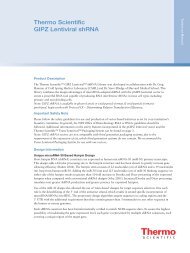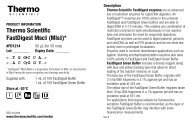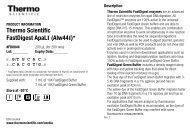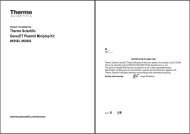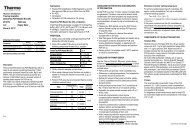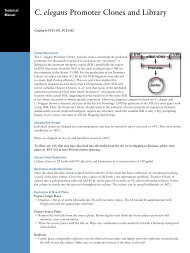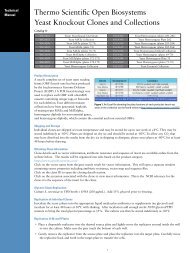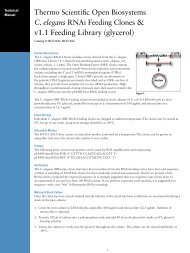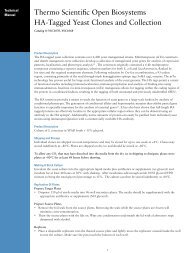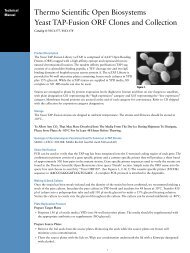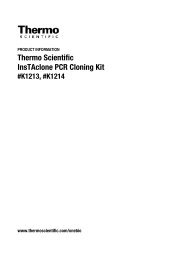Thermo Scientific Solaris qPCR Gene Expression Assays
Thermo Scientific Solaris qPCR Gene Expression Assays
Thermo Scientific Solaris qPCR Gene Expression Assays
You also want an ePaper? Increase the reach of your titles
YUMPU automatically turns print PDFs into web optimized ePapers that Google loves.
<strong>Thermo</strong> Scientifi c <strong>Solaris</strong><br />
<strong>qPCR</strong> <strong>Gene</strong> <strong>Expression</strong> <strong>Assays</strong><br />
<strong>Gene</strong>-specific <strong>qPCR</strong> assays with advanced probe technologies<br />
Simplified choice - one assay per target gene is all you need<br />
Accurate and consistent results have never been easier to obtain
042<br />
Introducing <strong>Thermo</strong> Scientifi c<br />
<strong>Solaris</strong> <strong>qPCR</strong> <strong>Assays</strong><br />
One <strong>Gene</strong>. One <strong>qPCR</strong> Assay. Simple.<br />
<strong>Thermo</strong> Scientifi c <strong>Solaris</strong> <strong>qPCR</strong> <strong>Gene</strong><br />
<strong>Expression</strong> <strong>Assays</strong> are pre-designed,<br />
gene specifi c probe and primer pairs<br />
that utilize minor groove binder (MGB TM )<br />
and Superbase technologies to deliver<br />
repeatable, sensitive and gene specifi c<br />
quantifi cation.<br />
Through the use of advanced software<br />
design and probe technologies, we have<br />
adopted a novel approach to designing<br />
<strong>qPCR</strong> probe detection assays. With this<br />
approach, we are able to design each<br />
assay to a consensus sequence that<br />
covers all known splice variants of the<br />
target gene. This strategy allows<br />
us to recommend one optimal assay<br />
for each gene target, making it easier<br />
than ever to incorporate the benefi ts<br />
of <strong>qPCR</strong> probe detection assays into<br />
your workfl ow.<br />
<strong>Solaris</strong> ® <strong>qPCR</strong> <strong>Assays</strong><br />
Advancements in <strong>qPCR</strong> Probe Technology<br />
Resulting in a Simplifi ed User Experience<br />
one assay is all you need
In addition to assay design advancements, <strong>Solaris</strong> <strong>qPCR</strong> <strong>Gene</strong><br />
<strong>Expression</strong> <strong>Assays</strong> also offer the following benefi ts.<br />
The sequence information is provided. Probe and primer sequence<br />
information is provided with every assay so you can publish<br />
with confi dence.<br />
The master mix is blue. <strong>Solaris</strong> <strong>Assays</strong> have been developed with<br />
our optimized, blue <strong>qPCR</strong> master mix for the best assay performance<br />
and ease-of-use. See your reagents as you pipette, track your<br />
progress across multiple wells, and visually assess your set-up.<br />
The pack sizes were created to fi t your needs. <strong>Solaris</strong> <strong>Assays</strong> are<br />
available from small to large pack sizes to accommodate all levels<br />
of throughput.<br />
The protocol is familiar. If you currently use <strong>qPCR</strong> probe assays,<br />
<strong>Solaris</strong> <strong>Assays</strong> will not require major changes to your protocol<br />
or routine.<br />
The result is a high performance assay. You can expect excellent<br />
results in terms of repeatability, sensitivity, dynamic range, effi ciency<br />
and specifi city.<br />
TABLE OF<br />
CONTENTS<br />
What is <strong>Solaris</strong> 4<br />
Why Choose <strong>Solaris</strong> 6<br />
More of What You Need 6<br />
Advanced Probe 6<br />
Confi guration and<br />
Chemistries<br />
Expert Assay Design 7<br />
Performance Data 8<br />
How to Order 10<br />
www.thermo.com/solaris<br />
3
044<br />
<strong>Solaris</strong> <strong>qPCR</strong> <strong>Gene</strong> <strong>Expression</strong> <strong>Assays</strong><br />
Easy to Choose:<br />
Take the Guesswork out of Selecting an Assay<br />
For the most simplifi ed quantifi cation strategy for your gene target, turn to <strong>Solaris</strong> <strong>qPCR</strong><br />
<strong>Gene</strong> <strong>Expression</strong> <strong>Assays</strong>. With one simple search for your gene, you will receive one<br />
recommended probe and primer assay for real-time PCR quantifi cation. Since <strong>Solaris</strong><br />
<strong>qPCR</strong> <strong>Assays</strong> are designed to detect all known splice variants of your target gene, one<br />
assay is all you need.<br />
What you get<br />
Each pre-designed <strong>Solaris</strong> <strong>qPCR</strong> Assay consists of a probe and primer pair specifi c to your<br />
target gene and includes the following:<br />
• All assay components at a 20X concentration.<br />
o Two primers provided at 800 nM each<br />
o One gene specifi c probe provided at 200 nM<br />
• The sequence information of your gene specifi c probe and primers<br />
• A high performance <strong>Solaris</strong> <strong>qPCR</strong> <strong>Gene</strong> <strong>Expression</strong> Master Mix (at a 2X concentration)<br />
compatible with your specifi c <strong>qPCR</strong> instrument model (ordered separately)<br />
By incorporating advanced chemistries into the design of <strong>Solaris</strong> <strong>qPCR</strong> <strong>Assays</strong>, we can<br />
offer gene specifi c assays that detect even the most challenging design targets, while<br />
ensuring every assay will perform optimally under the same thermal cycling conditions.<br />
Each assay incorporates the following components to achieve these optimal results:<br />
• Minor Groove Binder (MGB) moiety<br />
• Superbases (Super G, Super T, Super A)<br />
• FAM reporter<br />
• Eclipse ® Dark Quencher<br />
For up-to-date information on predesigned genomes available, visit<br />
the web at www.thermo.com/solaris.<br />
More information on<br />
these chemistries and<br />
how they enhance<br />
the performance of<br />
<strong>Solaris</strong> <strong>qPCR</strong> <strong>Assays</strong><br />
can be found on page<br />
Schematic representation of the<br />
<strong>Solaris</strong> probe with advanced<br />
probe chemistries<br />
6. The <strong>Solaris</strong> algorithm incorporates advanced<br />
chemistries like MGB and Superbases into<br />
the probe design in order to create highly<br />
specifi c assays for even the most diffi cult<br />
design targets.<br />
one assay is all you need
Advancements in <strong>qPCR</strong> Probe Technology<br />
Resulting in a Simplifi ed User Experience<br />
Easy to Use:<br />
Designed, Optimized, and Ready for Quantitative Analysis<br />
Expert Assay Design<br />
The <strong>Solaris</strong> design algorithm has been developed by experts in the fi eld of bioinformatics<br />
and incorporates unique design features and strict selection criteria in order to deliver high<br />
performance <strong>qPCR</strong> assays. <strong>Solaris</strong> <strong>qPCR</strong> <strong>Assays</strong> have been designed using this novel<br />
algorithm as well as BLAST scoring to ensure optimal assay specifi city.<br />
Universal Thermal Cycling Conditions<br />
As part of the assay design logic, the <strong>Solaris</strong> algorithm modifi es the probe and primer<br />
design to ensure assays perform optimally under the same thermal cycling conditions<br />
- often referred to as "universal thermal cycling conditions". This is achieved by<br />
incorporating an MGB moiety and Superbases into the assays to adjust, and thereby<br />
standardize, their melting temperature.<br />
Splice Variant Coverage<br />
To achieve accurate target quantifi cation, the expression levels of all known alternatively<br />
spliced transcripts should be measured. <strong>Solaris</strong> <strong>Assays</strong> are unique in that they are<br />
designed to detect all known splice variants by identifying a "consensus" region, one that<br />
is common among all splice variants, and designing the assays within this sequence.<br />
<strong>Solaris</strong> Master Mixes Give You Optimal Results – and They’re Blue!<br />
Optimized <strong>Solaris</strong> <strong>qPCR</strong> Master Mixes have been developed to ensure the best possible<br />
<strong>Solaris</strong> Assay performance. In addition to enhanced performance, these optimized reagents<br />
offer a unique feature – they’re blue. This allows visual confi rmation of set-up to eliminate<br />
pipetting errors and further enhance the repeatability of your data. <strong>Solaris</strong> <strong>qPCR</strong> Master<br />
Mixes are compatible with all commonly used real-time instrument platforms (Fig. 1).<br />
<strong>Solaris</strong> <strong>qPCR</strong> assays deliver high performance results across <strong>qPCR</strong> platforms<br />
ABI Prism ® 7900HT<br />
Effi ciency = 93%<br />
r2 = 1.000<br />
Roche LightCycler 480<br />
Effi ciency = 93%<br />
r2 = 0.999<br />
Stratagene Mx3000P<br />
Effi ciency = 91%<br />
r2 = 0.998<br />
Figure 1: <strong>Solaris</strong> gives highly reproducible assay results, as judged by the PCR effi ciency and r 2 values. PPIB was amplifi ed in quadruplicate from six ten-fold<br />
dilutions of cDNA synthesized from 100 ng total RNA on three instruments, ABI 7900HT (384-well format), Roche LightCycler 480 (384-well format) and Stratagene<br />
Mx3000P (96-well format). Calculated effi ciency and r 2 values are shown on each amplifi cation curve. The average C q value for the highest amount of input<br />
cDNA for the three instruments is 20.5 with standard deviation of +/- 0.6.<br />
www.thermo.com/solaris<br />
5
046<br />
Why Choose <strong>Solaris</strong> <strong>qPCR</strong> <strong>Gene</strong><br />
<strong>Expression</strong> <strong>Assays</strong> Over Others?<br />
MORE OF WHAT<br />
YOU NEED<br />
Compared to other probe detection options,<br />
you get more benefi ts and convenience<br />
with <strong>Solaris</strong> <strong>qPCR</strong> <strong>Assays</strong>.<br />
The Most Advanced Probe Confi guration and Chemistries<br />
Probe Design Leads to Low Background Signal<br />
In all <strong>qPCR</strong> probe detection assays, the confi guration of the probe plays an important role<br />
in the performance of the assay. Consequently, we have designed <strong>Solaris</strong> <strong>qPCR</strong> <strong>Assays</strong> in<br />
an ideal confi guration of FAM reporter, Eclipse Dark Quencher, and the MGB moiety. This<br />
unique arrangement leads to low background fl uorescence, independent of temperature<br />
over the range of PCR cycling conditions, thus providing a high signal-to-background ratio.<br />
Minor Groove Binder Increases Genome Coverage and Specifi city<br />
The proven MGB technology incorporated into <strong>Solaris</strong> probe design gives a signifi cant<br />
advantage over dual-labeled technologies that lack this moiety. The MGB moiety allows<br />
for highly specifi c, shorter probes to be designed while still maintaining the appropriate<br />
melting temperature, giving the <strong>Solaris</strong> algorithm more fl exibility or “design space” in<br />
which to develop the assay. This increased fl exibility is why we can offer predesigned<br />
assays for >98% of each genome.<br />
Superbases Enable Assay Design to Diffi cult Targets<br />
Just as the MGB moiety expands the design capabilities of the algorithm, Superbases<br />
perform a similar role. Superbases are chemical derivatives of native nucleotides and<br />
can increase the design fl exibility of the algorithm by turning diffi cult probe and primer<br />
sequences into viable genomic assays. The use of Superbases allows the algorithm to<br />
refi ne the T m, reduce secondary structure, improve mismatch discrimination and<br />
ultimately help deliver stable assays to even the most diffi cult design targets.<br />
The <strong>Solaris</strong> probe fl uoresces when bound to<br />
it’s specifi c target<br />
The <strong>Solaris</strong> MGB probe binds to linearized target in the annealing step and is<br />
displaced by the advancing DNA polymerase. Once back in its free state, the<br />
probe forms a coiled structure where the reporter and quencher are brought<br />
into close proximity by the MGB moiety, creating a low background signal.<br />
What you get What this means <strong>Solaris</strong> Supplier A Supplier Q<br />
Predesigned <strong>qPCR</strong> assays Time savings <br />
Assay sequence provided Publish with sequence data <br />
>98% Human genome coverage Complete pathway studies <br />
Fully optimized master mix Complete product system for optimal results <br />
What you can expect What this means<br />
Detect all known splice variants of gene Comprehensive analysis with one assay <br />
Universal thermal cycling conditions No preliminary optimization required <br />
Low background signal Improved sensitivity
The Difference is in the Algorithm<br />
The Power of <strong>Solaris</strong> Design<br />
Our bioinformatics experts have developed a robust algorithm that<br />
designs genomic assays based on optimal functionality, specifi city,<br />
and splice variant coverage. The result is a single recommended,<br />
high performance assay for your gene expression experiments. The<br />
algorithm incorporates the following design rules.<br />
• Multiple stringent probe and primer parameters for optimal assay<br />
performance<br />
• Selective placement of Superbases and use of MGB moiety for<br />
increased design fl exibility<br />
• Identifi cation of consensus sequence for splice variant coverage<br />
(see graphic below)<br />
• Exon junction spanning design when possible to avoid genomic<br />
DNA amplifi cation<br />
• BLAST analysis for assay specifi city<br />
Our powerful design algorithm eliminates the need for preliminary<br />
optimization so you can spend less time optimizing your assay and<br />
more time deciphering the complex biology of your experiment. The<br />
box to the right describes the detailed specifi cations that our algorithm<br />
takes into account for each <strong>Solaris</strong> <strong>qPCR</strong> <strong>Gene</strong> <strong>Expression</strong> Assay.<br />
Detect all known splice variants of your target<br />
gene for comprehensive target analysis.<br />
<strong>Solaris</strong> <strong>qPCR</strong> <strong>Assays</strong> are designed to a consensus sequence among all<br />
known splice variants so one assay provides comprehensive results.<br />
Genomic DNA<br />
PRIMER<br />
PRIMER<br />
Forward Primer<br />
Probe<br />
Reverse Primer<br />
<strong>Solaris</strong> Design Parameters<br />
1. When designing a functional assay, numerous design<br />
parameters are applied with high stringency, including:<br />
overall GC content, optimal sequence length, melting<br />
temperature (T m), stretches of homogenous nucleotides<br />
(i.e. GGGG).<br />
2. The algorithm adjusts the T m and enables universal cycling<br />
conditions by incorporating the MGB moiety and by<br />
selective placement of Superbases.<br />
3. When there is more than one splice variant for a target<br />
gene, a consensus (or common) sequence is identifi ed,<br />
representing design space where assays will detect all<br />
known splice variants (See graphic on this page).<br />
4. BLAST analysis is a critical component of any<br />
comprehensive <strong>qPCR</strong> assay design protocol and BLAST<br />
analysis has been integrated into the <strong>Solaris</strong> design<br />
algorithm. The algorithm utilizes genomic transcript and<br />
pseudogene databases to identify and eliminate sequences<br />
that are more likely to lead to erroneous priming and<br />
detection (i.e. off-target effects).<br />
5. To mitigate the potential for genomic DNA amplifi cation,<br />
the design algorithm, whenever possible, will place one of<br />
the assay components (probe or primer) or amplicon over<br />
an exon junction boundary.<br />
EXON 1 EXON 2<br />
EXON 3 EXON 4 EXON 5 EXON 6 EXON 7<br />
Splice Variants<br />
1<br />
PRIMER<br />
PRIMER<br />
EXON 1 EXON 2 EXON 3 EXON 4 EXON 6 EXON 7<br />
2<br />
EXON 1 EXON 2 EXON 3 EXON 5 EXON 6<br />
3<br />
PRIMER<br />
PRIMER<br />
PRIMER<br />
PRIMER<br />
EXON 1 EXON 2 EXON 5 EXON 6<br />
www.thermo.com/solaris<br />
7
048<br />
Why Choose <strong>Solaris</strong> <strong>qPCR</strong> <strong>Gene</strong><br />
<strong>Expression</strong> <strong>Assays</strong> Over Others?<br />
High Performance <strong>Assays</strong> for High Quality Results<br />
Linear Dynamic Range, Sensitivity, and PCR Effi ciency<br />
The linear dynamic range of a <strong>qPCR</strong> assay indicates how many<br />
orders of magnitude the assay can amplify consistently and<br />
effi ciently for the intended target. In robust <strong>qPCR</strong> assays, the<br />
linear dynamic range should span 5-6 log 10 dilutions. On the<br />
other hand, the sensitivity of a <strong>qPCR</strong> assay is expressed as the<br />
lower limit of detection (LOD). This is the lowest concentration<br />
that can consistently be detected in replicate samples. Here,<br />
we show high performance of <strong>Solaris</strong> <strong>qPCR</strong> <strong>Assays</strong> in terms of<br />
both linear dynamic range and LOD, using synthetic DNA and<br />
cDNA templates for amplifi cation (Fig. 2).<br />
Another measure of <strong>qPCR</strong> assay quality is high reaction<br />
effi ciency (ideally 95-105%), which indicates a doubling of<br />
amplifi ed product with every PCR cycle. Figure 3 illustrates<br />
the superb effi ciency that can be found across a population of<br />
<strong>Solaris</strong> <strong>Assays</strong>.<br />
<strong>Solaris</strong> <strong>Assays</strong> give high performance and reliable target detection at low input copy number<br />
DNA<br />
CDC20<br />
cDNA<br />
F2RL1<br />
<strong>Solaris</strong> <strong>Assays</strong> give high performance results<br />
across instrument platforms<br />
Figure 3: <strong>Solaris</strong> gives effi cient, repeatable detection of all gene targets on<br />
all commonly used <strong>qPCR</strong> platforms and targets.<br />
Effi ciency = 95%<br />
r 2 = 0.999<br />
Dyn Range = 10<br />
LOD = 5 copies<br />
Effi ciency = 97%<br />
r 2 = 0.998<br />
Dyn Range = 9<br />
LOD = 50 copies<br />
high performance <strong>qPCR</strong> assays<br />
Target <strong>Gene</strong> ID<br />
PCR Effi ciency<br />
(%)<br />
Repeatability<br />
(r2 r )<br />
ABI 7900HT RPS18 6222 98 0.996<br />
CDC45L 8318 100 1.000<br />
ZYX 7791 100 0.998<br />
RPS27L 51065 100 1.000<br />
RPLP2 6181 101 1.000<br />
Roche<br />
LightCycler<br />
480<br />
Mx3000P<br />
Stratagene<br />
C9orf86 55684 97 0.988<br />
MTHFD2 4522 98 1.000<br />
BACH1 571 99 0.999<br />
ACTB 60 100 0.999<br />
VIM 7431 101 1.000<br />
PPIB 5479 91 0.998<br />
B2M 567 93 0.999<br />
POLR2H 5437 93 0.996<br />
CENPE 1062 98 0.996<br />
Figure 2: <strong>Solaris</strong> <strong>Assays</strong> give reliable<br />
detection even at very low input<br />
concentrations, as judged by the PCR<br />
effi ciency and r 2 values. Ten 10-fold dilutions<br />
of cDNA synthesized from synRNA amplicon<br />
sequence or DNA amplicon sequence was<br />
amplifi ed on an ABI 7900HT instrument using<br />
<strong>Solaris</strong> <strong>qPCR</strong> <strong>Gene</strong> <strong>Expression</strong> Assay for F2RL1 or<br />
CDC20, respectively. The log-scale amplifi cation<br />
curves and standard curves are shown along<br />
with the performance of each assay including<br />
effi ciency, r 2 value, dynamic range out of 10 log 10<br />
dilutions and the lower limit of detection.
Feel Confi dent that Your Data is Highly Repeatable and Specifi c<br />
Repeatability & Reproducibility Specifi city<br />
Repeatability refers to the precision and robustness of the<br />
assay when the same samples are repeatedly analyzed<br />
in the same assay - in other words, intra-assay variance.<br />
Reproducibility refers to inter-assay variance. Both types of<br />
variance are minimized with the <strong>Solaris</strong> system, in part by<br />
providing the assay and optimized master mix in 20X and<br />
2X concentrations, respectively, thereby limiting the number<br />
of pipetting steps necessary. Excellent reproducibility is<br />
shown here in an RNAi knockdown experiment. Detection<br />
of the same gene targets and reference gene from a single<br />
experiment was performed by two researchers at two<br />
different sites. The same level of knockdown was detected<br />
for both target genes (Fig. 4).<br />
<strong>Solaris</strong> <strong>Assays</strong> are highly reproducible<br />
Target <strong>Gene</strong> <strong>Expression</strong><br />
(% of control)<br />
140<br />
120<br />
100<br />
80<br />
60<br />
40<br />
20<br />
0<br />
100nM<br />
10nM<br />
1nM<br />
0.1nM<br />
100nM<br />
10nM<br />
1nM<br />
ALDOA NTC Controls PPIB<br />
ALDOA detection<br />
0.1nM<br />
Mock<br />
Figure 4: <strong>Solaris</strong> <strong>Assays</strong> give consistent results even between different<br />
researchers and laboratories. siRNAs targeting ALDOA and PPIB, as well as a<br />
Non-targeting Control (NTC), were transfected into HeLa cells at 100, 10, 1 and 0.1 nM<br />
fi nal concentrations. Cells were harvested and total RNA isolated 48 hrs post-treatment.<br />
cDNA was synthesized using <strong>Thermo</strong> Scientifi c Verso cDNA Synthesis Kit. An aliquot of<br />
the cDNA was amplifi ed in two geographically separated laboratories using <strong>Solaris</strong> <strong>qPCR</strong><br />
<strong>Gene</strong> <strong>Expression</strong> <strong>Assays</strong> for detection of ALDOA, PPIB, and GAPDH on a Roche LightCycler<br />
480 (384-well) platform. Knockdown was calculated using the ΔΔC q method (normalized<br />
to GAPDH reference gene and NTC-treated cells). The same levels of knockdown were<br />
demonstrated for both gene targets between both researchers at both sites.<br />
Untreated<br />
100nM<br />
10nM<br />
1nM<br />
0.1nM<br />
100nM<br />
Site 1 Site 2<br />
10nM<br />
1nM<br />
0.1nM<br />
Mock<br />
Untreated<br />
NTC Controls<br />
PPIB detection<br />
high quality results<br />
<strong>Gene</strong> specifi city is the amplifi cation of the intended<br />
gene target without amplifying genomic DNA (gDNA) or<br />
unintentional targets (i.e. off targeting). <strong>Solaris</strong> <strong>Assays</strong> are<br />
designed to span exon-exon boundaries whenever possible<br />
so that amplifi cation of gDNA is avoided. For single exon<br />
genes there is potential for gDNA amplifi cation. Similarly,<br />
if there is a pseudogene target for an assay that spans an<br />
exon-exon junction, contaminating gDNA may be amplifi ed.<br />
Anytime these circumstances are true for a given assay, the<br />
information is provided to the researcher to allow for complete<br />
gDNA removal prior to reverse transcription. Figure 5<br />
demonstrates specifi city of <strong>Solaris</strong> <strong>Assays</strong> as single amplifi ed<br />
bands on an agarose gel.<br />
Specifi city of <strong>Solaris</strong> <strong>qPCR</strong> <strong>Gene</strong> <strong>Expression</strong> <strong>Assays</strong><br />
(A)<br />
SEC22B TKAF1 GNB4 NF1 NICN1 TAGLN2 PIGZ TIMM SEMA4A FBXL7 CITED2 FBX021<br />
bp<br />
800<br />
400<br />
200<br />
100<br />
(B)<br />
Figure 5: <strong>Solaris</strong> gives highly accurate results as judged by the specifi c<br />
amplifi cation of the target amplicon. (A) Duplicate wells of <strong>qPCR</strong> reactions postamplifi<br />
cation (40 cycles; total reaction volume loaded on gel) run on 4% agarose gels<br />
(100 ng total RNA input into 20 μL cDNA synthesis reaction). (B) Duplicate wells of six<br />
10-fold cDNA dilutions (100 ng total RNA input into 20 μL cDNA synthesis reaction) and<br />
no template control (NTC) run on 4% agarose gel demonstrates specifi city of <strong>Solaris</strong><br />
<strong>qPCR</strong> <strong>Assays</strong>.<br />
1 Bustin,S.A., Benes,V., Garson,J.A., Hellemans,J., Huggett,J., Kubista,M., Mueller,R., Nolan,T., Pfaffl ,M.W.,<br />
Shipley,G.L. et al. (2009) The MIQE guidelines: minimum information for publication of quantitative real-time PCR<br />
experiments. Clin. Chem., 55, 611–622.<br />
www.thermo.com/solaris<br />
bp<br />
400<br />
300<br />
200<br />
100ng 10ng 1 ng 0.1ng 0.01ng 0.001ng NTC<br />
100<br />
TAGLN2<br />
9
04 10<br />
Search Your <strong>Gene</strong>. Find Your Assay. Simple.<br />
Search Your <strong>Gene</strong> at www.thermo.com/<strong>Solaris</strong>Search<br />
to Find the Optimal <strong>Solaris</strong> <strong>qPCR</strong> Assay.<br />
For best results, add optimized reagents at the time of your order.<br />
<strong>Solaris</strong> <strong>qPCR</strong> <strong>Gene</strong><br />
<strong>Expression</strong> <strong>Assays</strong><br />
(20X solution)<br />
<strong>Solaris</strong> <strong>qPCR</strong><br />
Master Mixes<br />
(2X solution)<br />
Part Number Reactions (25 μL volume) Fill Volume<br />
<strong>Gene</strong> specifi c<br />
www.thermo.com/<br />
<strong>Solaris</strong>Search<br />
See back cover for more ordering options.<br />
For up-to-date information on estimated delivery times, please inquire<br />
or visit the web.<br />
Sequence Information<br />
Provided<br />
100 125 μL <br />
200 250 μL <br />
400 500 μL <br />
1000 1250 μL <br />
Part Number Reactions (25 μL volume) Fill Volume Format<br />
Instrument Specifi c<br />
See table on page 11<br />
or select online<br />
Verso cDNA Kit Part Number Reactions (20 μL volume)<br />
AB-1453/A 40<br />
AB-1453/B 100<br />
100 1.25 mL 1 x 1.25 mL Tube<br />
200 2.5 mL 2 x 1.25 mL Tubes<br />
400 5 mL 4 x 1.25 mL Tubes<br />
1000 12.5 mL 2 x 6.25 mL Tubes<br />
optimized solaris <strong>qPCR</strong> master mixes
<strong>Solaris</strong> <strong>qPCR</strong> Master Mix Selection Chart<br />
PROBE<br />
ABI<br />
Mix + ROX<br />
Vial<br />
ROX Mix<br />
Low ROX<br />
Mix<br />
7000 ●<br />
7300 ●<br />
7500 ●<br />
7700 ●<br />
7900 ●<br />
7900HT ●<br />
StepOne ●<br />
StepOne Plus<br />
Bio-Rad<br />
●<br />
iCycler ●<br />
MyiQ ●<br />
iQ 5 ●<br />
Opticon ●<br />
Opticon 2 ●<br />
Chromo 4 ●<br />
MiniOpticon<br />
Cepheid<br />
●<br />
SmartCycler Corbett<br />
●<br />
Rotor-<strong>Gene</strong> Eppendorf<br />
●<br />
Realplex<br />
Roche<br />
●<br />
Lightcycler ® 480<br />
Stratagene<br />
●<br />
Mx4000 ® ● ●<br />
Mx3000P ® ● ●<br />
Mx3005P ® Techne<br />
● ●<br />
Quantica ® 2. Find Your Compatible Mix<br />
1. Select Your <strong>qPCR</strong> Cycler<br />
●<br />
3. Choose Your<br />
Preferred Format<br />
<strong>Solaris</strong>TM s <strong>qPCR</strong> <strong>Gene</strong> <strong>Expression</strong><br />
Master Mix<br />
Reactions<br />
(25 µL volume)<br />
Format<br />
100 1 x 1.25 mL Tube AB-4350/INT AB-4351/INT AB-4352/INT<br />
200 2 x 1.25 mL Tubes AB-4350/A AB-4351/A AB-4352/A<br />
400 4 x 1.25 mL Tubes AB-4350/B AB-4351/B AB-4352/B<br />
1000 2 x 6.25 mL Tubes AB-4350/C AB4351/C AB-4352/C<br />
The complete <strong>Solaris</strong> detection<br />
system requires <strong>Solaris</strong> <strong>qPCR</strong><br />
Master Mix for optimal results.<br />
Select the high performance<br />
mix for your <strong>qPCR</strong> instrument<br />
model using the table here or<br />
select a mix online when<br />
placing your order.<br />
one assay is all you need<br />
Need help? Contact our <strong>qPCR</strong> technical<br />
support team<br />
North America - (US, Canada, Central/South America)<br />
Telephone: (800) 235-9880, (303) 604-9499<br />
Techservice.genomics@thermofi sher.com<br />
Europe - (EU, Middle East, Africa, Asia)<br />
Techservice.emea.genomics@thermofi sher.com<br />
Telephone:<br />
United Kingdom<br />
Telephone: 01372 840 410<br />
France<br />
Telephone: 01 60 92 48 68<br />
Germany<br />
Telephone: 040 23 51 36 79<br />
Rest of World<br />
Telephone: +44 1372 840 410<br />
www.thermo.com/solaris<br />
11
<strong>Thermo</strong> Scientifi c <strong>Solaris</strong><br />
<strong>qPCR</strong> <strong>Gene</strong> <strong>Expression</strong> <strong>Assays</strong><br />
Contact Information<br />
Web: www.thermo.com/solaris<br />
US e-mail: techservice.genomics@thermofi sher.com<br />
Europe e-mail: techservice.emea.genomics@thermofi sher.com<br />
North America<br />
2650 Crescent Dr., Suite 100<br />
Lafayette, CO 80026<br />
Toll free: 800 235 9880<br />
Tel: 303 604 9499<br />
Fax: 303 604 3286<br />
Belgium<br />
Tel: 0800 80543<br />
Fax: 0800 80178<br />
Technical support: +44 1372 840 410<br />
France<br />
Tel: 08009 14294<br />
Fax: 08009 11885<br />
Technical support: 01 60 92 48 68<br />
Germany<br />
Tel: 0800 1830746<br />
Fax: 0800 1810366<br />
Technical support: 040 23 51 36 79<br />
The Netherlands<br />
Tel: 08000 223464<br />
Fax: 08000 223291<br />
Technical support: +44 1372 840 410<br />
United Kingdom<br />
Tel: 08009 171501<br />
Fax: 01372 840545<br />
Technical support: 01372 840 410<br />
Switzerland<br />
Tel: 08005 63505<br />
Fax: 08008 38669<br />
Technical support: +44 1372 840 410<br />
Other Countries:<br />
Technical support: +44 1372 840 410<br />
US Literature # 000234-09-J-01U<br />
Euro Literature # PB 2009 57<br />
© 2009 <strong>Thermo</strong> Fisher Scientifi c Inc. All rights reserved. Trademarks are the property of their respective owners. All trademarks are the property of<br />
<strong>Thermo</strong> Fisher Scientifi c Inc. and its subsidiaries.




